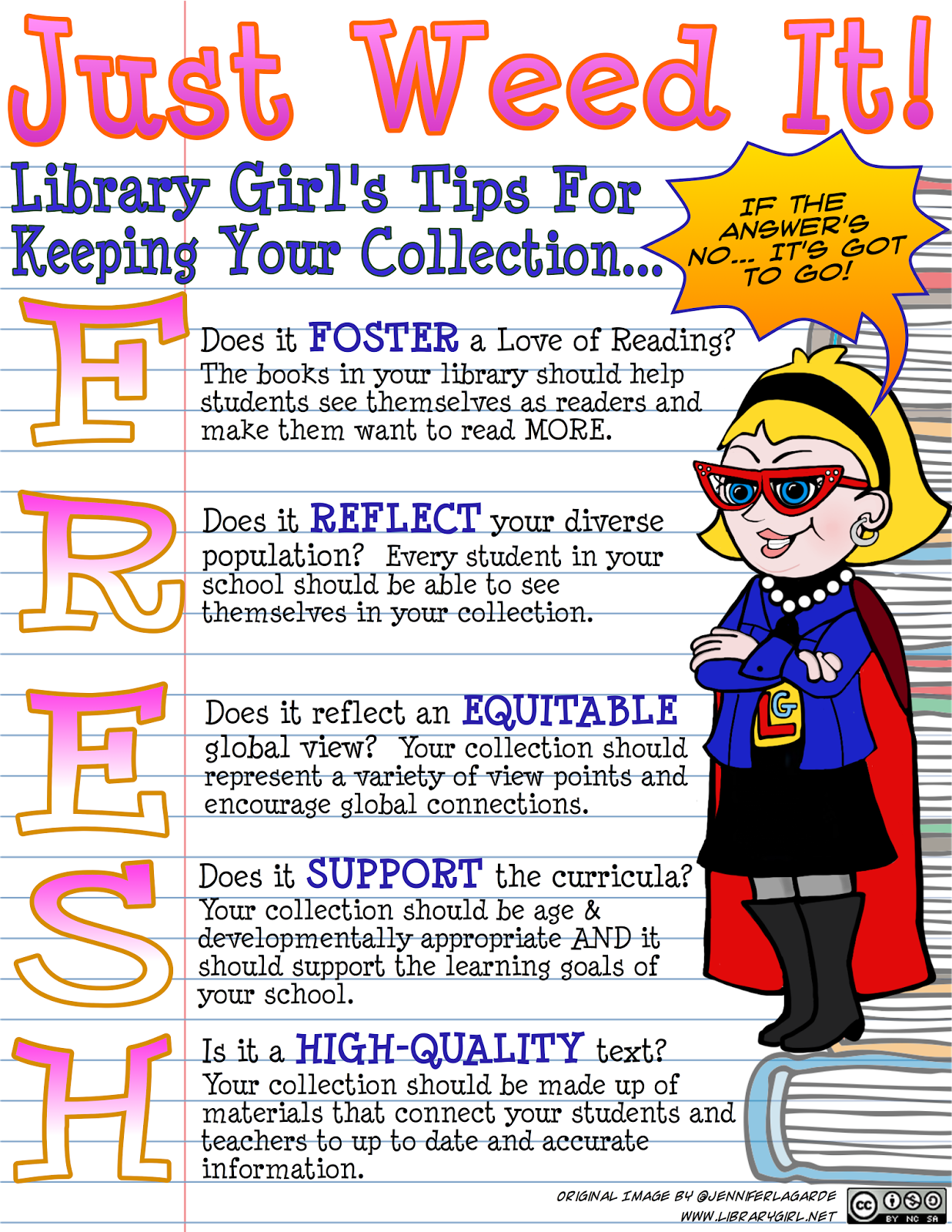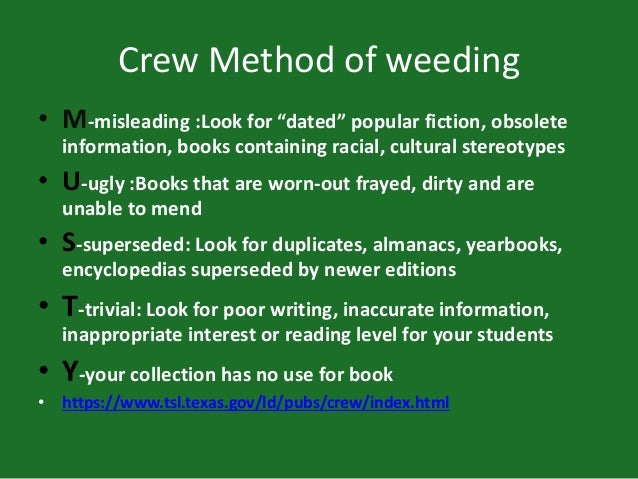NYC School Librarian Guidebook: Weeding
-
“In too many libraries, collection development is actually based on the book as an object. Public libraries should not be in the business of accumulating physical objects. The purpose should be to provide the content that is needed and used by the public." Texas Public Library Standards
- Discard Letter - 2022-2023A current letter from the Director of Library Services outlining why libraries need to discard of inappropriate library materials.
Just Weed It !

-

MUSTY

Weeding
WEEDING GUIDELINES
Weeding/De-selection Guidelines
Weeding is an essential component of any collection development plan in order to
maintain a collection that meets the needs of students and the curriculum. The weeding
guidelines should include reasons for weeding and criteria for de-selection. The
following points may be used as the foundation for weeding guidelines:
You Need to Weed…
• To maintain a current, useful, dynamic collection
• To adapt to changing needs and interests of students and teachers
• To accommodate changes in the school’s curriculum
• To make the best use of floor and shelf space
• To improve the physical appearance of the collection
• To assess the collection’s strengths and weaknesses
• To increase circulation
Weeding Criteria
• Length of time since the book was last checked out (on average 5 years)
• Age of the book in terms of copyright date (on average 5 years, although age is
more telling in some parts of the Dewey scheme than in others, e. g., medical,
legal, current events, and computer subjects need to be very current)
• Condition of the book
Some useful web sites for weeding are:
Weed It! For An Attractive and Useful Collection
www.wmrls.org/services/colldev/weed_it.html
Sunlink Weed of the Month Club
www.sunlink.ucf.edu/weed
Weeding the School Library
http://www.cde.ca.gov/ci/cr/lb/documents/schoollibweedng.pdf
Weeding the Neglected Collection by Doug Johnson
http://www.doug-johnson.com/dougwri/weeding.html
A Rule of Thumb Chart for Weeding the Collection Dewey Number
Suggested Copyright Guidelines to Discard
- 000 2-10 years (computer tech books may age faster)
- 100 10 years
- 200 2-10 years
- 300 5-10 years
- 400 10 years
- 500 5-10 years (some science titles may age faster)
- 600 5-10 years (technology titles may age faster)
- 700 5-15 years
- 800 Flexible
- 900 5-10 years (country books, atlas, maps may age faster)
- Biographies Flexible; 10 years for contemporary subjects
- Encyclopedias 5 years (consider online versions)
- Almanacs 3 years
- Periodicals 3 years; 6 months if superseded by electronic resources
- Fiction 10 years (you may want to keep award winners)
- Audio & Video Check periodically for condition and content
- CD ROMs Format compatibility changes quickly
Deselected items must be disposed of properly and removed from your shelf list, inventory and catalog, following the guidelines for disposal of obsolete library books. Items may be donated (if the recipient is made fully aware of the reason for discarding), sent for recycling, disposed of through incineration, or sent to a book buyback program authorized by NYC Public Schools. The labels and all evidence of NYC Public Schools ownership must be removed before disposition takes place. Buy a “Discard” stamp and stamp each item on the front and back inside cover. Make arrangements with the custodial staff before discarding items to avoid any problems. Equipment, including computers, may be disposed of according to NYCPS guidelines.
Weeding Resources
- Weed It ! - Book cart drill teamHave fun while weeding !
CREW
Most of these criteria come from Belinda Boon, The CREW Method; Expanded Guidelines for Collection Evaluation and Weeding for Small and Medium-Sized Public Libraries (Austin, Texas: The Texas State Library, 1995)
